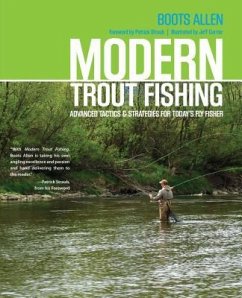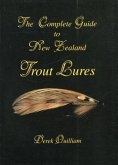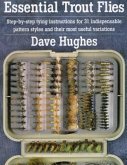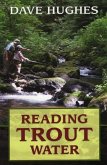- Broschiertes Buch
- Merkliste
- Auf die Merkliste
- Bewerten Bewerten
- Teilen
- Produkt teilen
- Produkterinnerung
- Produkterinnerung
Acomprehensive examination of the latest methods of trout fishing being used by anglers the world over, Modern Trout Fishing investigates the most recent research in ocular, aural, and scent characteristics of trout; contemporary trends in dry fly, nymph, and streamer fishing; useful approaches to casting and fly presentation; and the newest and hottest fly patterns. Research is based on the author’s thirty plus years of guiding and fishing around the world, and his conversations and experiences with some of the best anglers and guides in the sport.
Andere Kunden interessierten sich auch für
![Nymph-Fishing Rivers and Streams Nymph-Fishing Rivers and Streams]() Rick HafeleNymph-Fishing Rivers and Streams29,99 €
Rick HafeleNymph-Fishing Rivers and Streams29,99 €![Sight Fishing for Trout Sight Fishing for Trout]() Landon MayerSight Fishing for Trout22,99 €
Landon MayerSight Fishing for Trout22,99 €![Complete Guide to New Zealand Trout Lures Complete Guide to New Zealand Trout Lures]() Derek QuilliamComplete Guide to New Zealand Trout Lures24,99 €
Derek QuilliamComplete Guide to New Zealand Trout Lures24,99 €![The Trout Dreams The Trout Dreams]() Derek GrzelewskiThe Trout Dreams19,99 €
Derek GrzelewskiThe Trout Dreams19,99 €![Essential Trout Flies Essential Trout Flies]() Dave HughesEssential Trout Flies19,99 €
Dave HughesEssential Trout Flies19,99 €![Stalking Trophy Brown Trout Stalking Trophy Brown Trout]() John HoltStalking Trophy Brown Trout19,99 €
John HoltStalking Trophy Brown Trout19,99 €![Reading Trout Water Reading Trout Water]() Dave HughesReading Trout Water22,99 €
Dave HughesReading Trout Water22,99 €-
-
-
Acomprehensive examination of the latest methods of trout fishing being used by anglers the world over, Modern Trout Fishing investigates the most recent research in ocular, aural, and scent characteristics of trout; contemporary trends in dry fly, nymph, and streamer fishing; useful approaches to casting and fly presentation; and the newest and hottest fly patterns. Research is based on the author’s thirty plus years of guiding and fishing around the world, and his conversations and experiences with some of the best anglers and guides in the sport.
Produktdetails
- Produktdetails
- Verlag: Globe Pequot Publishing
- Seitenzahl: 224
- Erscheinungstermin: 2. April 2013
- Englisch
- Abmessung: 231mm x 188mm x 12mm
- Gewicht: 550g
- ISBN-13: 9780762780266
- ISBN-10: 0762780266
- Artikelnr.: 36693632
- Herstellerkennzeichnung
- Libri GmbH
- Europaallee 1
- 36244 Bad Hersfeld
- gpsr@libri.de
- Verlag: Globe Pequot Publishing
- Seitenzahl: 224
- Erscheinungstermin: 2. April 2013
- Englisch
- Abmessung: 231mm x 188mm x 12mm
- Gewicht: 550g
- ISBN-13: 9780762780266
- ISBN-10: 0762780266
- Artikelnr.: 36693632
- Herstellerkennzeichnung
- Libri GmbH
- Europaallee 1
- 36244 Bad Hersfeld
- gpsr@libri.de
By Joseph Allen
Introduction: A history of fly-fishing with an emphasis on the progression
of tactics. This book, Modern Trout Fishing, is the most recent in a long,
aristocratic line of texts.
Chapter 1: What Trout See, Hear, and Smell
Part of what makes fly fishing so damn enjoyable is the way the sport lends
itself to learning more about the environment, including characteristics of
fish and wildlife. Studying the aural, ocular and scent traits of trout
make you both a more astute, and better, angler.
Chapter 2: Holding Water
Understanding where trout hold, when, and why, will greatly increase ones
chances at catching trout. Factors to consider include velocity and depth,
temperature, oxygen levels, current breaks, and behavioral differences
among various trout species.
Chapter 3: Dry Fly Strategies and Tactics
The most popular type of trout fishing, the factors to consider when dry
fly-fishing include dead drift, avoiding drag, how best to approach holding
water, the strip set (vs the “trout set”) and the mend. Tandem rigs offer
variability to selectively feeding trout, and a proper cast assures the
flies land appropriately.
Chapter 4: Nymphing Strategies and Tactics
Perhaps the most effective way to fish. It is becoming increasing popular
because of new and improved tactics by modern fly fishers and a better
exchange of info. The factors to consider include depth and line control,
indicator vs. no indicator, dropper systems (standard dry-dropper,
off-set), double, triple, and dropper loop riggings, and proper casts and
presentations for a variety of situations.
Chapter 5: Streamer Strategies and Tactics
Traditionally, no type of fly fishing has been more overlooked, but
advances in tackle and tactics has made it much more effective. It is
important to understand depth and holding water as well as water column and
thermocline factors. Critical factors include the use of the latest
tackle, retrieval techniques, hook sets, and types of patterns (size,
color, stinger, etc.).
Chapter 6: Favorite Flies
Traditional patterns are still very effective and serve as templates for
many of the latest flies. Today, there is a lot of influence from
saltwater, warm water, and anadromous fly fishing. The flies presented
here I consider the most effective depending on one’s situation.
Chapter 7: Conserving What We Have
Despite over-fishing and the degradation of trout habitat, conservation
efforts on the part of anglers have had a dramatic impact on protecting our
fish. Still, there are more threats and a lot more to be done.
Volunteering, contributing, lobbying, and being vocal are important
individual tools.
of tactics. This book, Modern Trout Fishing, is the most recent in a long,
aristocratic line of texts.
Chapter 1: What Trout See, Hear, and Smell
Part of what makes fly fishing so damn enjoyable is the way the sport lends
itself to learning more about the environment, including characteristics of
fish and wildlife. Studying the aural, ocular and scent traits of trout
make you both a more astute, and better, angler.
Chapter 2: Holding Water
Understanding where trout hold, when, and why, will greatly increase ones
chances at catching trout. Factors to consider include velocity and depth,
temperature, oxygen levels, current breaks, and behavioral differences
among various trout species.
Chapter 3: Dry Fly Strategies and Tactics
The most popular type of trout fishing, the factors to consider when dry
fly-fishing include dead drift, avoiding drag, how best to approach holding
water, the strip set (vs the “trout set”) and the mend. Tandem rigs offer
variability to selectively feeding trout, and a proper cast assures the
flies land appropriately.
Chapter 4: Nymphing Strategies and Tactics
Perhaps the most effective way to fish. It is becoming increasing popular
because of new and improved tactics by modern fly fishers and a better
exchange of info. The factors to consider include depth and line control,
indicator vs. no indicator, dropper systems (standard dry-dropper,
off-set), double, triple, and dropper loop riggings, and proper casts and
presentations for a variety of situations.
Chapter 5: Streamer Strategies and Tactics
Traditionally, no type of fly fishing has been more overlooked, but
advances in tackle and tactics has made it much more effective. It is
important to understand depth and holding water as well as water column and
thermocline factors. Critical factors include the use of the latest
tackle, retrieval techniques, hook sets, and types of patterns (size,
color, stinger, etc.).
Chapter 6: Favorite Flies
Traditional patterns are still very effective and serve as templates for
many of the latest flies. Today, there is a lot of influence from
saltwater, warm water, and anadromous fly fishing. The flies presented
here I consider the most effective depending on one’s situation.
Chapter 7: Conserving What We Have
Despite over-fishing and the degradation of trout habitat, conservation
efforts on the part of anglers have had a dramatic impact on protecting our
fish. Still, there are more threats and a lot more to be done.
Volunteering, contributing, lobbying, and being vocal are important
individual tools.
Introduction: A history of fly-fishing with an emphasis on the progression
of tactics. This book, Modern Trout Fishing, is the most recent in a long,
aristocratic line of texts.
Chapter 1: What Trout See, Hear, and Smell
Part of what makes fly fishing so damn enjoyable is the way the sport lends
itself to learning more about the environment, including characteristics of
fish and wildlife. Studying the aural, ocular and scent traits of trout
make you both a more astute, and better, angler.
Chapter 2: Holding Water
Understanding where trout hold, when, and why, will greatly increase ones
chances at catching trout. Factors to consider include velocity and depth,
temperature, oxygen levels, current breaks, and behavioral differences
among various trout species.
Chapter 3: Dry Fly Strategies and Tactics
The most popular type of trout fishing, the factors to consider when dry
fly-fishing include dead drift, avoiding drag, how best to approach holding
water, the strip set (vs the “trout set”) and the mend. Tandem rigs offer
variability to selectively feeding trout, and a proper cast assures the
flies land appropriately.
Chapter 4: Nymphing Strategies and Tactics
Perhaps the most effective way to fish. It is becoming increasing popular
because of new and improved tactics by modern fly fishers and a better
exchange of info. The factors to consider include depth and line control,
indicator vs. no indicator, dropper systems (standard dry-dropper,
off-set), double, triple, and dropper loop riggings, and proper casts and
presentations for a variety of situations.
Chapter 5: Streamer Strategies and Tactics
Traditionally, no type of fly fishing has been more overlooked, but
advances in tackle and tactics has made it much more effective. It is
important to understand depth and holding water as well as water column and
thermocline factors. Critical factors include the use of the latest
tackle, retrieval techniques, hook sets, and types of patterns (size,
color, stinger, etc.).
Chapter 6: Favorite Flies
Traditional patterns are still very effective and serve as templates for
many of the latest flies. Today, there is a lot of influence from
saltwater, warm water, and anadromous fly fishing. The flies presented
here I consider the most effective depending on one’s situation.
Chapter 7: Conserving What We Have
Despite over-fishing and the degradation of trout habitat, conservation
efforts on the part of anglers have had a dramatic impact on protecting our
fish. Still, there are more threats and a lot more to be done.
Volunteering, contributing, lobbying, and being vocal are important
individual tools.
of tactics. This book, Modern Trout Fishing, is the most recent in a long,
aristocratic line of texts.
Chapter 1: What Trout See, Hear, and Smell
Part of what makes fly fishing so damn enjoyable is the way the sport lends
itself to learning more about the environment, including characteristics of
fish and wildlife. Studying the aural, ocular and scent traits of trout
make you both a more astute, and better, angler.
Chapter 2: Holding Water
Understanding where trout hold, when, and why, will greatly increase ones
chances at catching trout. Factors to consider include velocity and depth,
temperature, oxygen levels, current breaks, and behavioral differences
among various trout species.
Chapter 3: Dry Fly Strategies and Tactics
The most popular type of trout fishing, the factors to consider when dry
fly-fishing include dead drift, avoiding drag, how best to approach holding
water, the strip set (vs the “trout set”) and the mend. Tandem rigs offer
variability to selectively feeding trout, and a proper cast assures the
flies land appropriately.
Chapter 4: Nymphing Strategies and Tactics
Perhaps the most effective way to fish. It is becoming increasing popular
because of new and improved tactics by modern fly fishers and a better
exchange of info. The factors to consider include depth and line control,
indicator vs. no indicator, dropper systems (standard dry-dropper,
off-set), double, triple, and dropper loop riggings, and proper casts and
presentations for a variety of situations.
Chapter 5: Streamer Strategies and Tactics
Traditionally, no type of fly fishing has been more overlooked, but
advances in tackle and tactics has made it much more effective. It is
important to understand depth and holding water as well as water column and
thermocline factors. Critical factors include the use of the latest
tackle, retrieval techniques, hook sets, and types of patterns (size,
color, stinger, etc.).
Chapter 6: Favorite Flies
Traditional patterns are still very effective and serve as templates for
many of the latest flies. Today, there is a lot of influence from
saltwater, warm water, and anadromous fly fishing. The flies presented
here I consider the most effective depending on one’s situation.
Chapter 7: Conserving What We Have
Despite over-fishing and the degradation of trout habitat, conservation
efforts on the part of anglers have had a dramatic impact on protecting our
fish. Still, there are more threats and a lot more to be done.
Volunteering, contributing, lobbying, and being vocal are important
individual tools.








